Lex in depth: why the luxury market needs to hedge against China
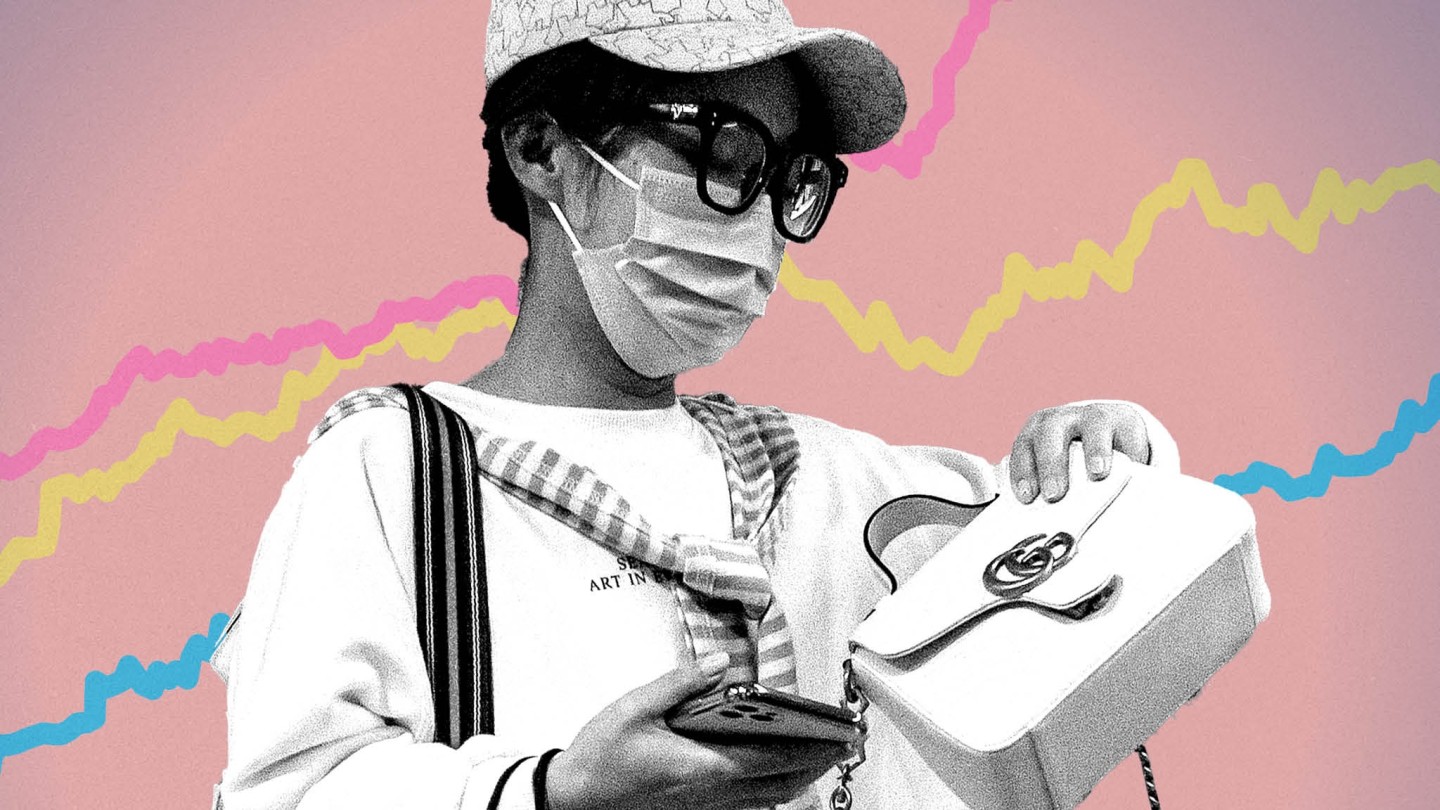
Roula Khalaf, Editor of the FT, selects her favourite stories in this weekly newsletter.
Customers at the exclusive Shinsegae department store in the Gangnam district of Seoul prefer to display their wealth discreetly. But their high spending was exposed to the wider world when it revealed annual sales had topped $2bn in 2021 — the highest turnover for a single store in the world. It outpaced even Harrods in London, which before the coronavirus pandemic had long held the world’s top spot.
Global travel restrictions partly explain the success of department stores such as Shinsegae across Asia. Chinese and Korean luxury consumers previously reserved their biggest shopping sprees for European holidays. Covid-19, however, prompted them to pick up high-priced items at local department stores, which were unaffected by lockdowns.
This shift of turnover from Europe to Asia could mark a more permanent change in the balance of power within the global luxury industry. These changes in the spending habits of Asian consumers — the driving force of the luxury goods sector worldwide — have far-reaching implications for global brands and even some economies.
Asian shoppers, who accounted for more than 60 per cent of global luxury spending in 2021 — a market worth $300bn excluding cars — have delivered record profits for brands such as LVMH, with its shares more than doubling during the pandemic to become the most valuable stock in Europe by market capitalisation at the start of 2022.
But against this backdrop China’s economy is slowing and Beijing has unleashed a crackdown on its billionaires. That could trigger a rerun of the plunge in luxury demand seen during the country’s last anti-corruption drive in 2012.
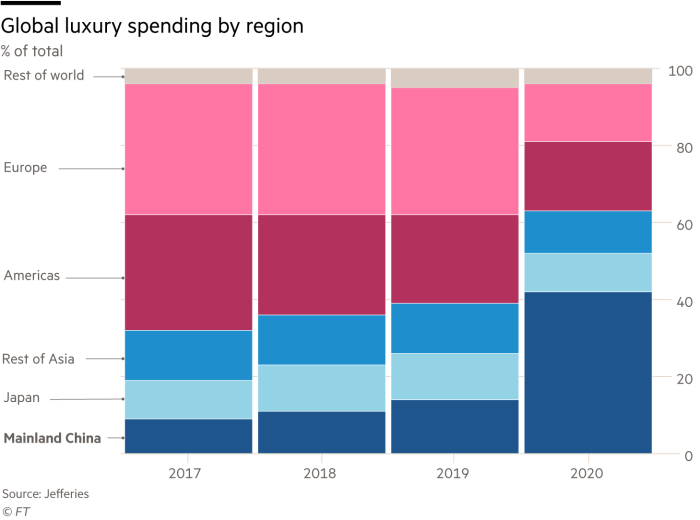
A long-term shift in sentiment and spending habits cannot be ruled out. Nor can a profitability squeeze. Luxury brands are losing their lucrative premium pricing strategies in Asia which could trigger a lasting reversal in the lofty valuations of European luxury goods companies.
The sector now needs a hedge against its biggest customer: China.
China’s luxury open runs
Lines of up to 300 people outside Chanel boutiques in Beijing and Seoul department stores hours before opening have become a common sight in the past year, with some camping overnight to protect their place in the queue.
These so-called open runs have even created their own job opportunities. For $150 a morning, a substitute will queue for you. Or, to guarantee success, you can pay an 80 per cent premium on the product price for a reseller to stand in line until they get their hands on the desired object. Chanel and other brands have responded by rationing handbags. In Seoul, for example, sales of its most popular bags are limited to just one per person, per year, and passport and identification numbers are employed to track every sale.
The rationing, long lines and occasional loud quarrels associated with open runs have made headlines, providing free marketing for brands and contributing to a bumper 2021 for the world’s top five luxury brands: Gucci, Dior, Louis Vuitton, Chanel and Prada.
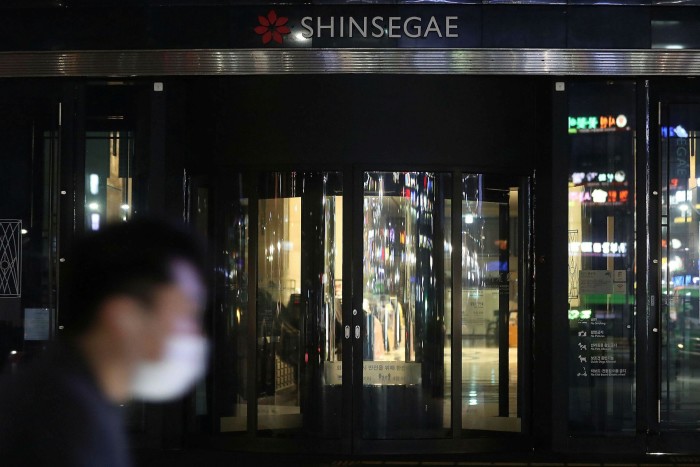
LVMH’s 2021 group sales were up a fifth compared to its previous record in 2019 to €64.2bn, led by its fashion and leather goods unit, its largest business, which analysts estimate generates profit margins of more than 40 per cent. “The business is showing some very good momentum in many countries outside China too,” says LVMH chief financial officer Jean-Jacques Guiony. “This includes Korea, whose contribution in terms of revenue is not far off that of France.”
The surge in prices for assets ranging from equities — especially US tech stocks — to bitcoin during the pandemic has helped drive wealth creation.
Asia-Pacific now has more billionaires than any other region of the world. Yet less than a third of global luxury brand sales come from these ultra-high net worth shoppers. The rest is from the rising middle class.
In 2019, Chinese consumers bought luxury goods worth about $120bn: about 70 per cent of that spending was made outside the country. But as overseas sales of personal luxury goods fell to near zero over the past two years, those inside mainland China climbed. In 2021 alone, they increased more than a third to Rmb471bn ($71bn), according to Bain estimates. That’s more than double the 2019 luxury spending in mainland China.
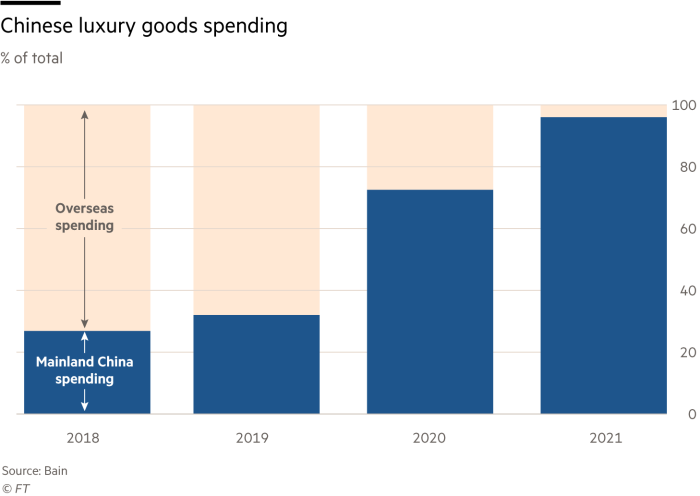
Asia’s price premium evaporates
The lack of flights to Europe is not the only reason Asian shoppers are doing their luxury spending at home. An equally important factor is the narrowing of the price differential between Europe and Asia. Traditionally there has been a significant gap that made the same products far more expensive in Asia due to the pricing strategies of luxury brands, local taxes and logistics.
The premium, which added up to 80 per cent on the same products in China a few years ago, meant a first-class flight to Paris for a shopping trip still cost less than the same spree at home.
That price gap — the reason Chinese consumers have long been the most profitable for global luxury brands — has, since the pandemic, narrowed to an average of 30 per cent. For some brands such as Chanel, the price differential between China and Europe is even lower — down to just about a tenth.
At the same time, the war in Ukraine means that the rebound in Europe is unlikely to be swift. “Even beyond Covid, the social and political turbulence in Europe does not pave the way for any immediate resumption of tourism,” says Claudia D’Arpizio, Bain’s global head of fashion and luxury. “Even when the Chinese are free [from Covid restrictions] and willing to travel back to Europe, I don’t see them buying abroad as they [used to].”
Another byproduct of the pandemic is the way the luxury goods industry has embraced ecommerce after years of snubbing it, over fears that an online presence could potentially damage the image of some brands. Now, such platforms are critical to the marketing and sales strategies of those same brands. In China, sales of luxury goods, which accounted for just a tenth of total online market share in 2019, peaked at 80 per cent of total sales during the pandemic.
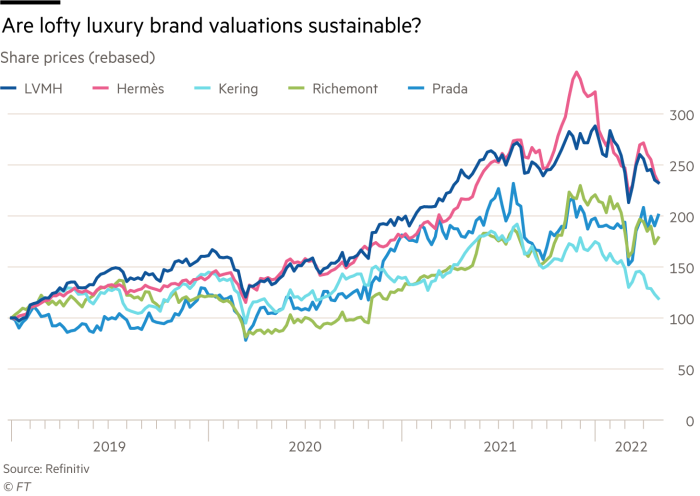
That gives luxury brands the opportunity to cut costs in Asia and take full advantage of trends towards online purchases, including direct sales through messaging apps and courier delivery services. That also puts at risk the once-seemingly bulletproof revenue streams of Asian department stores and their business models, built around receiving 30 to 40 per cent of total sales as a commission.
European luxury groups have traditionally cultivated demand by selling their brands as status symbols in China, a country that has seen a huge growth in its middle class over the past two decades, with many of them working in the booming tech sector.
“This group earns big bonuses, usually multiples [of their] annual salary. That is where their purchasing power has been coming from,” says Iris Pang, chief economist for greater China at ING.
That in turn helped boost the value of shares in Europe’s luxury groups. LVMH and Hermès reached decade high valuations last year on a forward earnings basis, with the latter reaching 65 times at the end of 2021, reflecting the buying frenzy in Asia. Current valuation levels, while short of those highs, imply that the current double-digit earnings growth will continue.
But longer term, lower average selling prices could hold back the profitability of luxury brands. A return to the operating margins of 24 per cent enjoyed a decade ago is unlikely. Indeed, the risk of further lockdowns and restrictions in China’s wealthiest cities means a return to 2020’s operating margins of just 10 per cent cannot be ruled out.
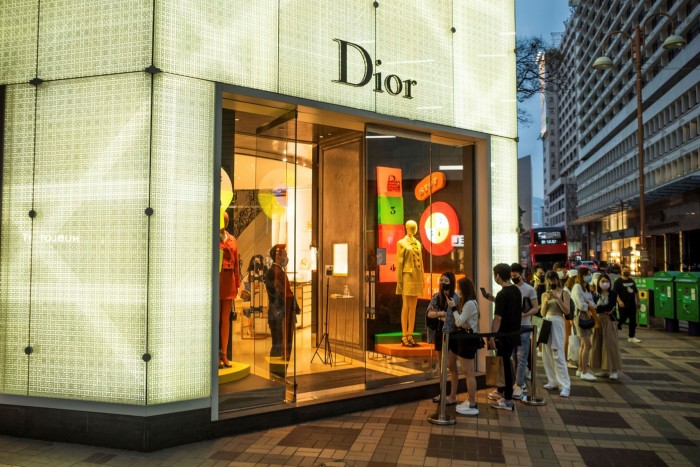
The shift in spending to Asia means entire economies are taking a hit. Hong Kong, which does not tax luxury goods sales, has long benefited from being an important shopping destination for mainland Chinese, Korean and Japanese tourists, who all faced higher domestic prices for the same items.
Mainland Chinese visitors made up about 80 per cent of total Hong Kong tourists before the pandemic and accounted for 60 per cent of total luxury sales in the city — a figure that has since fallen more than 90 per cent.
At the same time, Hong Kong residents are leaving the city at a record rate, according to official data. The city’s retail sales in March fell almost 14 per cent from a year earlier. Lifestyle International, which owns and operates Hong Kong’s Sogo department stores, reported a record loss in 2021.
“Hong Kong has long been one of the most important hubs for luxury consumption [in Asia], but that is no longer the case,” says D’Arpizio at Bain, adding that mainland Chinese tourists are unlikely to return in the same numbers. “We do not expect Hong Kong to recover on this front as people can buy luxury goods duty-free in China now, [in places] such as Hainan. There will be a period of Hong Kong store closures for luxury brands.”
Xi’s ‘common prosperity’ drive
Shanghai, home to the flagship stores of global brands, has for weeks been living with a lockdown that has trapped 26mn residents in their homes. The city’s economy “will shrink 6 per cent in the month of April alone if the current lockdown persists”, says Pang at ING. And luxury sales will not escape that second quarter hit. With restrictions spreading to other cities, including Beijing, analysts expect annual growth across the country of just 4.2 per cent, well below the official state forecast of about 5.5 per cent.
Beyond the shorter-term impact of the lockdowns and the country’s zero-Covid policy, mainland China’s shopping habits are expected to undergo profound change. The biggest risk to global brands remains political: President Xi Jinping’s commitment to “common prosperity” and a pledge to redistribute wealth.
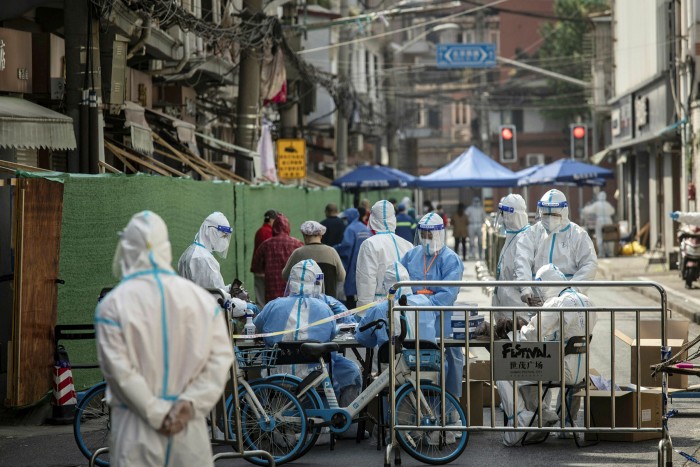
When the policy was announced in August, shares in the largest luxury groups plummeted. Paris-listed Kering, owner of the Gucci brand, fell by a fifth as did LVMH and Switzerland’s Richemont, the company behind the watchmakers Cartier and Piaget. But since then most investors have shrugged off the plunge.
Yet if China’s anti-corruption drive of 2012 is any guide, the worst is still to come for the luxury groups. Back then the clampdown led to a sharp drop in profits for Europe’s luxury brands and shattered sales expectations for everything related to luxury, from handbags to private jets. It lasted four years.
The latest crackdown has drawn in a range of characters from tech billionaires to film stars, social media influencers and private tutoring start-ups. Its breadth suggests it may be more enduring than its 2012 forerunner.
Meanwhile Chinese officials have blamed foreign brands for creating the consumer credit bubble, claiming millennials — the driving force behind new luxury goods purchases in China — borrow money to pay for them. The debt-to-income ratio of China’s post-1990s generation had already reached a record of more than 1,800 per cent in 2018, according to an HSBC survey. Since then official household debt levels have grown further.
In this environment, prudent Chinese shoppers may decide it is better to hide rather than flaunt their wealth. That could mean moving away from luxury brands entirely.
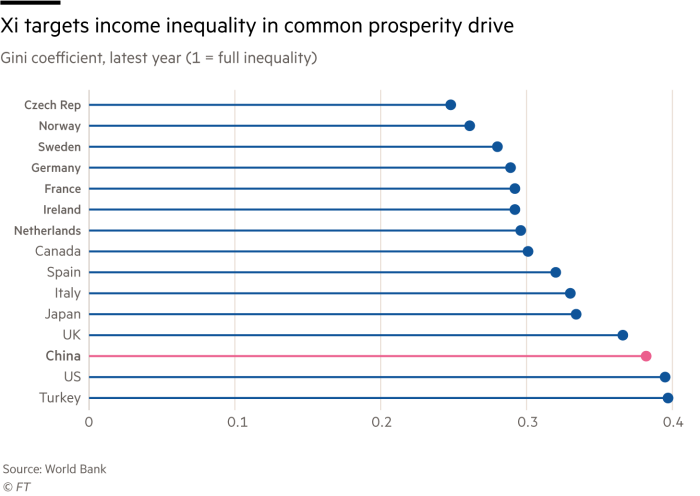
That is a problem for an industry that is expected to rely on the under-40s for almost three-quarters of its total sales by 2025. And may force the brands, as part of their hedge, to shift resources to other markets.
Some argue that if common prosperity expands the middle class in China that may be positive for luxury sales. Yet such arguments look overly optimistic. The middle class has expanded, but its growth and spending power remains fragile. At $10,400, gross domestic product per capita remains far behind the luxury sector’s next biggest market, the US.
The greatest risk: China
Lockdowns are weighing heavily on an already slowing Chinese economy. The youth jobless rate climbed to 16 per cent, a two-year high, at the end of March, nearly triple the national average. Patriotic shoppers, championing domestic brands, who have previously led boycotts against the likes of Burberry and Dolce & Gabbana, could also apply a brake on luxury goods sales.
Sectors outside luxury have already taken a hit. Canadian winter wear producer Canada Goose has slashed revenue and profit expectations after it was hit by nationalist backlash over a no-returns policy in 2021. H&M and Nike have faced boycotts over their refusal to use cotton sourced from Xinjiang, where Beijing is accused of detaining Muslim Uyghurs. That has sparked a shift to home grown brands.
“The increasing support for homegrown brands is a long-term trend, which we believe will persist.” says Scott Chen, managing partner at private equity group L Catterton. “[This is] in part due to rising national pride, but more importantly because of improving product quality and narratives that resonate with consumers.”
Brands already face rising costs of transport, logistics and raw materials. The headwinds in Asia mean shoppers have become more selective. Traditionally, in the years following an economic slowdown, sales of hard luxury — watches and jewellery — have taken a prolonged hit. In China, the sector outlook for luxury watches, which during the 2012 anti-graft drive became a national symbol of corruption, is more vulnerable.
The biggest risk according to D’Arpizio is that “luxury brands are so dependent on a single market”.
For years Chinese consumer appetite for luxury products moved in lockstep with the nation’s economic growth. When China was growing at 10 per cent a year, as it did for the decade leading up to 2012, so did luxury goods sales.
The reality remains that global luxury demand will face pressure as long as Chinese growth keeps slowing. The looming political risks make it hard to trust the sustainability of the buying frenzy of the past two years. There is now a greater need for investors and luxury brands to hedge against China.
Comments